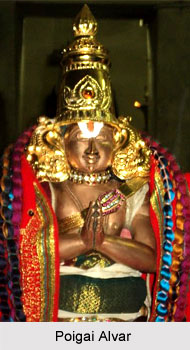 Poigai Alvar, also known as Poikai Azhwar, was a renowned Vaishnava saint poet of the Tamil country who existed during the 7th Century AD. He was one amongst the twelve Alvar mendicant saints of Southern India, who are acknowledged for their association to Vaishnava tradition of Hinduism. The temples worshipped by the songs and hymns of the Alvars (Azhwars) were known as Divya desam. Poigai Alvar composed the literary work of Mudal Thiruvandaadhi (Mudhal Thiruvandhadhi), which comprises of one hundred paasurams or hymns that are included in the Divya Prabandham, also known as Nalayira Divya Prabandham. Divya Prabandham is an anthology of 4,000 verses in Tamil, composed by the 12 Alvars before 8th century AD. It was compiled by Nathamuni during the 9th century- 10th century. Poigai Alvar, meaning Pond in Tamil, was a follower of the Vaishnava Bhakti philosophy.
Poigai Alvar, also known as Poikai Azhwar, was a renowned Vaishnava saint poet of the Tamil country who existed during the 7th Century AD. He was one amongst the twelve Alvar mendicant saints of Southern India, who are acknowledged for their association to Vaishnava tradition of Hinduism. The temples worshipped by the songs and hymns of the Alvars (Azhwars) were known as Divya desam. Poigai Alvar composed the literary work of Mudal Thiruvandaadhi (Mudhal Thiruvandhadhi), which comprises of one hundred paasurams or hymns that are included in the Divya Prabandham, also known as Nalayira Divya Prabandham. Divya Prabandham is an anthology of 4,000 verses in Tamil, composed by the 12 Alvars before 8th century AD. It was compiled by Nathamuni during the 9th century- 10th century. Poigai Alvar, meaning Pond in Tamil, was a follower of the Vaishnava Bhakti philosophy.
Early Life of Poigai Alvar
Poigai Alvar (Poikai Azhwar) was born in a village near Kanchipuram in the seventh century CE. He was one of the prominent Alvar saints, who was found as a child close to a pond near a temple devoted to Lord Vishnu. It is widely believed by the followers of Vaishnavism that Poigai Alvar was the incarnation of the divine conch of Lord Vishnu, termed as Panchajanyam in Tamil.
Compositions of Poigai Alvar
Poigai Alvar has composed numerous beautiful Paasurams or verses on Lord Vishnu in his devotional literary work of Mudal Thiruvandaadhi or Mudhal Thiruvandhadhi. It comprises as one of the compositions in Divya Prabandham (Nalayira Divya Prabandham). The one hundred verses composed by the poet saint forms the initial part of the Divya Prabhandham anthology. The verses of Poigai Alvar in Mudal Thiruvandaadhi commence with the words Vaiyam Tagaliya, Varkadale Neyyaaga, which means that the poet saint is reciting the garlands of Paasurams (verses) which are devoted to the supreme Lord. He further compares the vision of Lord Vishnu with the light of the lamp of the earth, oil is compared with the seas and the sun is considered as the source of the divine light of Lord Vishnu.
The hymns in the literary work of Mudal Thiruvandaadhi written by Poigai Alvar describe that the poet composed the song as it granted him knowledge and wisdom. In his work, he compared the vision of the Lord with the light of the lamp and the fuel of devotion as the seas; the sun is the supreme source of all forms of life which have originated from the light of Vishnu. In the Prabandham, Poigai Alvar mentions that he has committed himself to the service of Perumal (Lord Vishnu). The Vaishnava poet saint composed 100 paasurams or hymns for Nalayira Divya Prabandham. The verses of Mudal Thiruvandaadhi start from 2082 paasurams and conclude at 2181 paasurams of Divya Prabandham.













